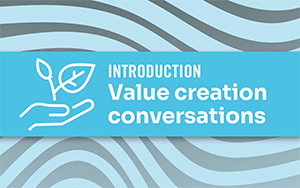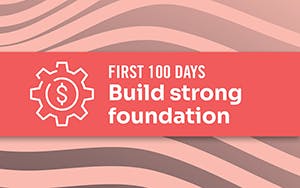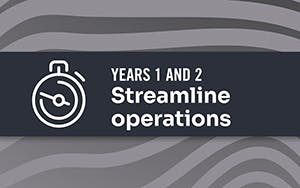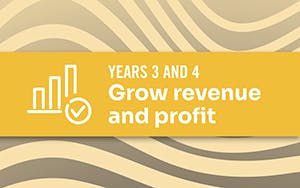
Multimedia | Stage 5 of the private equity transaction life cycle
Years 5 and 6: Prepare for exit
Value Creation Conversations
In this video, Michael Milani, executive managing director with Baker Tilly Capital, LLC shares key points of the fifth stage of the transaction life cycle: Prepare for exit.
Key topics discussed:
- Overview of Baker Tilly Capital, LLC
- Preparing companies for market readiness
- Criteria for determining marketability
- Developing a 5-year projection model through information gathering
- Key considerations and data for management preparation
- Timing considerations for the overall process
Watch the video now for a deep dive into those important years 5 and 6.
All value creation conversations videos
Contact Baker Tilly Capital
Mike Milani: Hi, my name is Mike Milani. I'm a principal and executive managing director with Baker Tilly Capital.
Interviewer: Today we're going to talk about years five and six in the private equity life cycle, preparing for exit. I'm excited to be here. Tell us a little bit about Baker Tilly Capital.
Mike Milani: Baker Tilly Capital is a boutique investment bank that's owned by Baker Tilly. We do four things, we focus on buy-side and sell-side M&A. We do capital sourcing as well as project finance, and we do corporate finance advisory.
Interviewer: Thank you. So how do you help companies get ready to go to market?
Mike Milani: Good question. So getting companies ready to go to market is a time-consuming process, especially if you're a company that hasn't gone through the process before or you have a private equity owner that is not ready to enter into a process and you've got to get everything ready in a relatively short period of time.
So the way we start is we typically pitch for a piece of work. So we talk about valuation, we talk about buyers, we talk about sale process, talk about timing, then we talk about fees.
And then assuming we win the pitch, then we basically start getting the company ready to go to market. We start with what's called an information request list, which is a spreadsheet of a bunch of questions, and we focus on what the company does, what its history is, key investment considerations, the financial performance of the company, customers, suppliers, IT, employees, all the components that will help us write an offering memorandum.
And that information request list typically takes a period of time to pull together. And at the same time, we're also building out a data room, because the way to think about a sale process is if you're going to sell a company, you have to think like a buyer. So if you're going to bring a company to market, you have to be prepared to be a buyer and what information that buyer will need and what information that buyer is going to require in their due diligence process.
So think of it in terms of building blocks, or a building that's being built. You start with the information, you write an offering memorandum, make sure that offering memorandum goes into the company's narrative voice, so it's a very collaborative effort with the company.
And basically, once that offering memorandum is ready to go and the buyer list is approved, and we spend a lot of time building a buyer list, private equity is typically a longer list than strategics, we get a teaser together, which is a two-page document. We send that to the buyers. They then are asked to execute non-disclosure agreements. And once those non-disclosure agreements are done, we send out the offering memorandum and ask for offers.
So that's a very short synopsis of how we get companies ready to go to market. I'll touch on some other things later.
Interviewer: Great, thank you. What do you look for when you're bringing companies to market?
Mike Milani: It's a very good question. Are they saleable is really the first way to answer that. So if we have the opportunity to pitch for a piece of work on a sell-side, we want to know are we meeting valuation expectations? Are they ready to go to market? Can they gather the information? Is there going to be a universe of buyers that are going to be interested in the opportunity? And is there a timeline that we can meet that has reasonable expectations about when a transaction will get done?
The second component to that is, are they ready from an information perspective? So I talked briefly about the information request list. It's a very lengthy list. There's a lot of information to be gathered, and how long is it going to take the company to pull all that stuff together?
And assuming they can pull the information together and we revise our analysis on valuation, because that's the key component for almost everybody, and we're still aligned with valuation expectations and we still think it's a marketable company, we're going to green-light and go and start talking to buyers.
Interviewer: How do you make sure that they have all of their ducks in a row?
Mike Milani: We're going to talk about ducks. So if anyone's ever been to the Peabody hotel in Memphis, there are all these ducks that march in a row out of the elevator into the little pond in the middle, it's really more of a fountain. And to have that happen is pretty spectacular, and it's worse with companies.
So the issue with companies is how well organized is the information that they have? How is it to go through due diligence? Because ultimately, it's nice that we gather the information, but we're more concerned about the accountants, the lawyers, the environmental, the IT, the HR, the benefits, due diligence folks starting to look at the information on the other side when the letter of intent is agreed to. So gathering the information, synthesizing the information.
Typically, what we find the most difficult to do is normalizing EBITDA. So think about a process where you've got a company's historic financial statements. We then make EBITDA adjustments to those financial statements. And in many instances, they work with quality of earning providers, which Baker Tilly, we'll talk about in another segment.
And basically, we take historic EBITDA, adjust EBITDA for a pro forma latest 12 months EBITDA, and then we come up with a revised budget for the fiscal year that they're in. And then the really hard lifting happens in and around projections. Most companies, unless they're private equity owned, do not prepare projections on a regular basis.
So basically, what you're doing is you're asking the management team to come up with sales assumptions, market share assumptions. You're also asking them to come up with inflation assumptions, pricing assumptions to really quantify and qualify what the revenue's going to be.
And then on the expense side, cost of goods sold, there's a lot of variability in cost of goods sold today with supply chain and all the other factors. And we go through the company assumptions around that, and then we build out the SG&A assumptions and then we drill down all the way to the operating profit line, the EBIT line. And then we talk about capital expenditures and then we drive appreciation and amortization off of those.
So effectively what you are doing is developing a five-year projection model with all the company's assumptions and making sure that the, back to the beginning, the data that is the company today, the pro forma EBITDA and the projections all have congruity. And when due diligence is occurring, and the management's team is talking about projections, their story is consistent and is, to the best of their knowledge, accurate in how the business is going to look in the future.
So the financials is really the hardest thing. The other thing, quite frankly, is getting management prepared to answer questions. So what we find is that management, unless it's private-equity owned, has not done this before. It's their first rodeo.
So you've got to get people prepared to speak to specific sections of the document, of the data room, of the due diligence that's been prepared, information that's been prepared. And they have to work in conjunction not only with ourselves, but also the attorneys, because the attorneys will ultimately write the purchase agreements. And they also have to be able to talk other industry and what I'd call just subject matter experts, be that environmental, be that HR, be that IT, be that benefits, and there's more and more. ESG is another thing that's popped up quite a bit in the last six months here.
So having all that data prepared, having people to be able to speak to that data, and having people be comfortable that's representing the buyers is really important. So lots of sequencing of stuff, but eventually, basically you take streams of information, you get them coherently organized in the data room, you figure out who's going to be able to talk to that, and then at that point, hopefully their ducks are in a row.
Interviewer: Thank you. That's helpful. It sounds like a lot. What's the timing like for that?
Mike Milani: I would say it depends on the company, right? So imagine a Broadway play, right? So if you were to go to Wicked, which is back in Chicago here again, so all the stuff that I just talked about typically happens behind the curtain. So if you are getting ready to take the company to market, you have all that preparation to happen behind the curtain, right? So and that can take a couple of months, it can take six months. Sometimes it takes years, so it really depends on how well-organized the company is and how ready they are to go to market and when they want to go to market. But I would say under a typical circumstance, you're talking about a two-month period.
Interviewer: Thanks. That's helpful. Can you give me an example of a company that you helped go to market?
Mike Milani: In a short process, sure. So we did a non-core divestiture last year that was introduced to us by our transaction advisory services team. A larger financial services company wanted to sell a business that does background checks. So if I wanted to drive for Uber, they would background check me. And I may be after this show, so we'll see.
What happened in that particular situation is there was a number of transactions that had occurred in that market at some really good multiples, and the company decided to go to market very quickly. Baker Tilly started doing some carve-out financials, which is not quality of earnings level, but still carve-out. And basically, they carved out the revenue, the cost of goods sold, allocated people and allocated some overhead expenses, and that was a pretty robust process that took about two months to do.
And concurrently, with that process, we started working on the offering memorandum, right? So we had a rough idea of what EBITDA, adjusted EBITDA was going to be. And we started out with what the valuation could be, who the buyers could be and what the process could look like.
So started writing that offering memorandum as those numbers were coming in, so we're able to block out all the heavy stuff. What does the company do? Who are their customers? What is the IT backbone of the company? Who are the people? And how is the company going to grow in the future? Because the business had a very, very strong tailwind behind it.
So basically, everything came together at the end. The book had been written, the numbers were coming together. We got the adjusted financials on a trailing 12 months basis. The company had worked off of that to come up with their budget for the remaining portion of the year as well as for their projections. And that came together in about, call it two months, nine/ten weeks. We went to market very quickly. We ran a very quick process. And start to finish, we were done in less than five months.
Interviewer: Wow. That's great.
Mike Milani: Very, very quick.
Interviewer: What about a company with a longer cycle?
Mike Milani: So, good story. We sold a food company earlier this year, and we had literally figured out that we had met with them four years almost to the day.
So we met this gentleman and one of our partners in a very nice restaurant, Southern Barbecue, that's nice for me. And we started talking about what he wanted to do, and he had just bought the business from his uncle a couple years prior. And he said, "Hey, I've got this great growth store. I'm going to add production capacity. I want to diversify my customer base. I want to improve my profitability mix and I want to put in a new IT system. I want to hire management."
So he had this vision for the future, but he also had a vision more importantly for what he wanted to walk away with kind of after tax dollars.
And as we got done with dinner, and we stayed in touch with this gentleman for a few years obviously before we won the sale mandate, the reply was, "If you're doing all that, don't sell now. If you think it's going to take you a year or two or longer to do that, you should do that. And if all that stuff comes together, we think the value of business is going to be worth 2X. And by default, the walkaway equity is going to be more than 2X than what you're talking about here today."
So basically, we kept talking to the company, really nice guy. He did everything he said he was going to do, took a little longer, but that's okay, because of COVID primarily. And when we got to the point where he's like, "I think I'm ready," we went out and said, "Okay. Well, we're going to pitch you on who the buyers are." It didn't change much. But the valuation is changed a lot, 2X a lot, a lot. What the walkaway equity was going to be, very large number because he'd also paid down debt in the interim.
And we got to the point where we're like, "Yeah, you're ready. The valuation's there, the buyers are there, the net after tax proceeds are there, and you've got all your ducks in a row with regards to information." And then we started the process and that got done not in five months, but got done six to seven months, which is a pretty good process for us.
So longer lifestyle, longer period of courting, but they said they were going to do X and that was going to result in Y. And we're patient advisors, right? We want to help our clients. And we also want to be value architects, which we talk about every day at Baker Tilly. And in that particular instance, we built a lot of value because the company had built a lot of value.
Interviewer: Both exciting stories. Who were the buyers in both of those cases?
Mike Milani: Both of those buyers were private equity. So as we talked about earlier, we do run robust processes. In both instances, there were strategic buyers who were very interested, and private equity buyers who were more interested. And what we found in both cases is that the sellers were willing to roll over equity, willing to take a second bite of the apple.
And what we found is that the overall value proposition, enterprise value plus cash out day one, and the equity rollover as well as the partnership was very compelling in both instances, and legacy was also very important to both firms.
Interviewer: How often would you say that happens with the buyers? Are they most of the time wanting to do that or are they wanting to kind of drive off in the sunset?
Mike Milani: I would say most of our sellers are willing to participate in the equity. And we have some sellers that want to hand the keys over and just be done, right?
But the reality is, in today's market you need transitions, right? So even buyers that say to the sellers, "Hey, you can walk out as quickly as possible," the transitions take much longer than anticipated. In some instances they happen the next day, but in many instances you have to have a seller who's patient, especially as they're rolling over equity.
Interviewer: No, absolutely. Integration is key.
Mike Milani: Absolutely. In today's market, if you want to capture value day one and year one, year two, integration transitions are really important.
Interviewer: Thank you for watching. Count on Baker Tilly to guide you through every step of the transaction life cycle.




